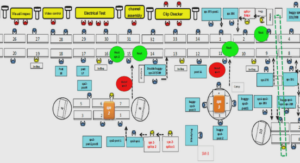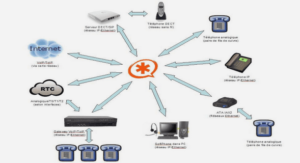Aircraft Performance modeling
The main goal of an aircraft performance model is to predict with a certain level of accuracy the actual aircraft and engine performance. The word “performance” in this context refers mainly to flight parameters describing the aircraft motion in the vertical plan (i.e. rate of climb/descent, acceleration, etc.), and also to the quantity of fuel required to perform a specific maneuver.
The typical structure of most aircraft performance models generally consists of a set of ordinary differential equations (used to describe the aircraft behavior) and two sub-models: a propulsion model and an aerodynamic model. The propulsion model allows, as its name suggests, to estimate the characteristics of the engines of the aircraft (i.e., thrust and fuel flow). The aerodynamic model, on the other hand, is used to estimate the aerodynamic characteristics of the aircraft, often expressed as its aerodynamic coefficients.
Nowadays, there are two main alternatives for researchers to obtain and/or design performance models. These alternatives are either to use “ready-to-use” performance models provided by specialized organizations, or to develop their own models based on available data. However, in some cases, accessing these data might be very difficult due to confidentiality issues.
BADA Aircraft Performance Models
Currently, one of best solution for researchers to access aircraft performance models is to use the well-known Base of Aircraft DAta (BADA, family 3). BADA is a collection of more than 300 aircraft performance models developed and maintained by Eurocontrol Experimental Center (ECC) (Nuic, Poles & Mouillet, 2010). The popularity of BADA models can be explained in part by two reasons. Firstly, the models are developed with the active cooperation of aircraft manufacturers and airlines, and secondly, they are available free of charge under certain conditions.
BADA models are provided to users as ASCII files containing a set of aircraft-specific coefficients. These coefficients must be used with a set of equations established by Eurocontrol in order to calculate the engine performance and the aircraft drag. According to the “BADA Performance Modeling Report” (Poles, 2009), theses coefficients are determined from trajectories data published in aircraft flight manuals. These manuals typically include the Aircraft Flight Manual (AFM), the Flight Crew Operating Manual (FCOM), the Flight Planning Guide (FPG), or any equivalent numerical documents/software capable of generating trajectories data (Nuic, 2010).
The procedure used by Eurocontrol to derive their models is based on the Least Squares (LS) technique. More specifically, this technique is applied to identify the coefficients for drag, thrust, and fuel flow equations that satisfy the rate of climb/descent and fuel consumption data published in the aircraft flight manuals for different flight profiles (i.e., climb, cruise and descent). Such a technique has the advantage of being straightforward and relatively simple. However, it also has several drawbacks because the equations used to model thrust, drag and fuel flow would need to be simplified in order to facilitate the identification process.
The approach used in BADA to model the engine thrust in descent, for instance, is to assume that the idle thrust (i.e., thrust setting during the descent) is proportional to the maximum climb thrust (Poles, 2009, p. 21). Such an assumption is not justified in practice because of the fact that the engine behavior in descent is often more complex than in climb. In addition, the net engine thrust may be negative during the descent phase due to the ram drag, which may be greater than the gross thrust at high speed and high altitude, while it is always positive during the climb phase. Another simplification which can lead to modeling uncertainties concerns the influence of the Mach number on the drag coefficient. This aspect is neglected, which means that the compressibility effects above Mach 0.6 are not considered in the drag model equations (Poles, 2009, p. 24).
Thus, although widely accepted as a reference for trajectory prediction and simulation applications, studies have shown that the models of BADA family 3 do not robustly represent the actual aircraft performance over their entire flight envelope (Nuic, Poinsot, Iagaru, Gallo, Navarro & Querejeta, 2005; Nuic et al., 2010).
In 2005, a new family of BADA (family 4) was introduced with the objective of improving the accuracy of its BADA previous models (Nuic et al., 2005, 2010). This action was accomplished by modifying the model equations, and by using more detailed reference data from manufacturers. However, this version is available under strict license restrictions, which considerably limits its use. In addition, there are no technical publications allowing to evaluate the quality of the BADA family 4 models since Eurocontrol does not allow the publication of this kind of studies.
It should be noted that there are also commercial software that provide access to performance data or performance models. A notable example is Piano-X developed by Lyssis and which includes a large database of performance models for more than 500 commercial aircraft (Simos, 2006). A detailed list of this software can be found in (Filippone, 2008). Unfortunately, these software are expensive, and come with strict license agreements which prevents their use for commercial purposes. In addition, the aircraft models encompassed in this software are not necessarily developed in cooperation with aircraft manufacturers or airlines operators. Consequently, their reliability is not always guaranteed (Filippone, 2008).
Engine Performance Modeling
A direct approach for predicting engine performance would involve the use of Computational Fluid Dynamics (CFD) methods (Chen, Langella & Swaminathan, 2019). These methods aim to analyze the properties of the air flow from the inlet to the outlet of the engine by solving the Reynolds-Averaged Navier-Stokes (RANS) equations using highly sophisticated software. They are commonly used by manufacturers to improve the design of their engines. Blackburn, Frendt, Gagné, Genest, Kohler & Nolan (2007), for instance, showed how CFD methods have been used to increase the efficiency of the Rolls-Royce Avon engine by 0.4%. However, these methods are generally computationally time expensive and require a very good knowledge of the structure of the engine. As a result, this type of methods is more suitable for design studies than for engine performance studies.
Another way to model engine performance is based on the Component Level Model (CLM) approach. As the name suggests it, the CLM approach consists in decomposing the engine into several components (i.e., fan, compressor, combustor, turbine, etc.), and in modeling the behavior of each component using appropriate equations. This approach has been widely used by researchers over the past two decades to model engine behavior (Bazazzade, Shahriari & Badihi, 2009; Roberts & Eastbourn, 2014; Botez, Bardela & Bournisien, 2019), to assess engine performance deterioration (Ogaji, Sampath, Singh & Probert, 2002), or for engine fault diagnosis (Junjie Lu, Feng Lu & Jinquan Huang, 2018).
Although the CLM approach has led to very good results in all of these studies, it is unfortunately not suitable for the research presented in this thesis. Indeed, the equations used to model the different engine components are usually unknown functions of detailed geometrical characteristics of the engine, and this information is not available in the public domain. In addition, the CLM approach requires to model various internal parameters of the engines which are not necessary for the studies of aircraft performance.
A very simple way to model engine performance is to use empirical or semi-empirical models. These models are expressed using polynomials or power law equations, that describe the variations in engine thrust and fuel flow as functions of aircraft operating conditions (i.e., altitude, airspeed and flight phase). Most of these models can be found in various manuals dealing with engine/aircraft performance, such as those written by Ojha (1995), Raymer (2012), Torenbeek (2013), Young (2017), and Mattingly, Heiser, Pratt, Boyer & Haven (2018).
A comparison of several empirical equations was conducted by Ghazi, Botez & Messi Achigui (2015c) in order to model the engine thrust of the Cessna Citation X. The results obtained in this study demonstrated that the accuracy of the models varied depending on the operating conditions. In another study, Bartel & Young (2008) improved the model proposed by Torenbeek (2013) for the estimation of the thrust of a turbofan engine during takeoff and climb phases. The author also provided additional equations to model the engine fuel consumption in cruise. Rodriguez & Botez (2013), have used a similar technique to propose a generic model for the prediction of the maximum thrust of turbofan based on previous studies conducted by Howe (2000). Senzig, Fleming & Iovinelli (2009) investigated a new empirical model to estimate aircraft fuel consumption during terminal procedures .
INTRODUCTION |





